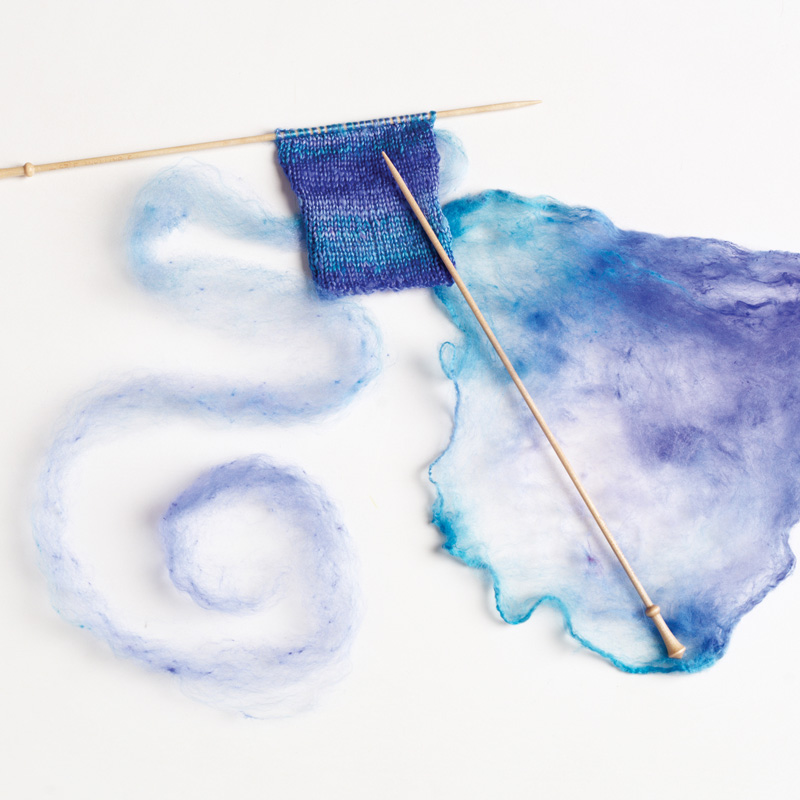Silk fiber can be slippery and challenging to spin, but spinning silk hankies or mawata is a whole different experience. In their article “Spinning Basics” from Spin Off Winter 2006, Amanda and Amy explored three types of silk yarn to make from hankies.
Chances are you already have a couple of dyed silk hankies tucked away in your stash—perhaps they were too alluring to pass up, even though you weren’t quite sure what to do with them.
Silk hankies or mawata are made from silk cocoons that are intact (the transformation of the silk worm into the moth was arrested so that the moth did not break through the cocoon) but not suitable for reeling. The cocoons are soaked in warm, soapy water to remove the sericin that binds the fibers together. The remains of the worm are removed, and the cocoon is stretched out and eased over a small wood frame (or in the case of silk caps and bells, over an archshaped mold). Each layer in a hankie is composed of several cocoons.
Before you start working with the silk, condition your hands with lotion, or you’ll find that the fine silk fibers will stick to cracks and crevices on your hands that you never knew you had. (Treenway Silks provides several suggestions for how to keep your hands smooth while you work with silk at www.treenwaysilks.com/kc-spin.php.)
Turn Silk Hankies into Roving
Photos by Joe Coca
Begin by separating out one translucent, filmy layer from the silk hankie with which to work. If it is too thick, it will be difficult to draft.
Pull outward from the edges of the hankie to begin the drafting process.
Eventually, the layer of silk will become so thin that the center will pull apart.
Now begin attenuating this doughnut shape into a long roving. Because the silk fibers are so long, they will not slip past one another if you hold your hands too close together. Move your hands farther apart if you are having difficulty drafting the fibers. Snapping the fibers between your hands is another way to draft them apart effectively.
Once you have attenuated the hankie layer to the thickness you desire, break the circle at any point along the edge. Wind the roving into a nest of fibers to spin from. You’re ready to begin spinning.
With this method of drafting, the silk fibers are aligned parallel to each other and so will be spun worsted-style with a short-draw technique. Silk fibers are very strong, so keep a firm grasp on the fibers and start by treadling slowly. You’ve done all the drafting work ahead of time, so you should be able to focus on introducing the amount of twist you want in your yarn. This yarn will be strong and fine— wonderful for embroidery, weaving, and lace knitting. Ply it to balance the yarn and add strength and diameter. Amanda learned this method of spinning silk hankies in a class with Maggie Casey at Shuttles, Spindles and Skeins in Boulder, Colorado. Maggie advocates spinning silk worsted-style to enhance the natural luster of the silk.
Spin from the Swift
Amy learned this method for drafting for a more woolen-style of yarn with the possibility of slubs (if you want them) from Celia Quinn at SOAR (Spin Off Autumn Retreat) 1998.
Dress a swift with a clean tea towel or other cloth to prevent the fibers from sticking to the wood.
Stretch a filmy, translucent layer of the silk hankie over the dressed swift.
Pull from the edge of the stretched silk and feed it onto the bobbin of your wheel as you treadle. You’ll have to do a bit more work drafting the strong silk fibers as you spin using this method, but the swift will hold the fibers as you work and will help keep them organized.
Knit Straight from the Hankie
Unspun silk from silk hankies makes a wonderful knitting yarn—simply follow the directions for drafting the fibers for worsted spinning and cast on using the unspun fiber. To achieve a thicker yarn, attenuate more than one layer of the hankie together. You can also weave with the unspun silk as the weft. The fibers blossom in the fabric and lend a soft and luxurious hand to the fabric. Wash your silk garments carefully in warm, soapy water. Avoid harsh alkaline detergents that will strip the fiber of its natural oils and make it brittle. Wool-safe detergents will work well with silk, as it is a protein fiber. Rinse well and lay flat to dry.
FREE TUTORIAL: Download Now
AMANDA BERKA is the former assistant editor of Spin Off magazine. AMY CLARKE MOORE served as editor of Spin Off from 2000–2015. Posted January 15, 2009. Updated August 13, 2017.




